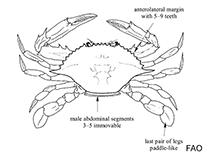Ovalipes punctatus (De Haan, 1833)
Sand crab
Envoyez vos Photos
Images Google | No image available for this species;
drawing shows typical species in Portunidae.
Images Google | No image available for this species;
drawing shows typical species in Portunidae.
Classification / Names Common names | Synonyms | CoL | ITIS | WoRMS
| Decapoda | Portunidae
Environment: milieu / climate zone / depth range / distribution range Écologie
. Subtropical
Distribution Pays | Zones FAO | Écosystèmes | Occurrences | Introductions
Southern Atlantic and Indo-West Pacific.
Length at first maturity / Taille / Poids / Âge
Maturity: Lm ? range ? - ? cm Max length : 9.5 cm CW mâle / non sexé; (Ref. 343)
Description synthétique Morphologie
Carapace rounded, surfaces finely granular, appearing almost smooth; 4 well-developed teeth on each anterolateral margin; stridulatory ridges present on ventral surface of palm. Color: carapace reddish brown to maroon, margins lighter colored; dactylus of fourth walking leg bluish purple.
Occurs at depths from 30 to 50 m. Usually, only the chelae are sold in the markets. Subtropical climate (Ref. 343).
Life cycle and mating behavior Maturité | Reproduction | Frai | Œufs | Fécondité | Larves
Members of the order Decapoda are mostly gonochoric. Mating behavior: Precopulatory courtship ritual is common (through olfactory and tactile cues); usually indirect sperm transfer.
Référence principale
Références | Coordinateur | Collaborateurs
Ng, P.K.L. 1998. (Ref. 343)
Statut dans la liste rouge de l'IUCN (Ref. 130435)
statut CITES (Ref. 108899)
Not Evaluated
CMS (Ref. 116361)
Not Evaluated
Menace pour l'homme
Harmless
Utilisations par l'homme
Pêcheries: commercial
| FishSource |
Outils
Plus d'informations
Pays
Zones FAO
Écosystèmes
Occurrences
Introductions
Stocks
Écologie
Régime alimentaire
Éléments du régime alimentaire
Zones FAO
Écosystèmes
Occurrences
Introductions
Stocks
Écologie
Régime alimentaire
Éléments du régime alimentaire
Sources Internet
BHL | BOLD Systems | CISTI | DiscoverLife | FAO(Publication : search) | Fishipedia | GenBank (genome, nucleotide) | GloBI | Gomexsi | Google Books | Google Scholar | Google | PubMed | Arbre de Vie | Wikipedia (Go, chercher) | Zoological Record
Estimates based on models
Catégorie de prix
(Ref. 80766):
Unknown.



